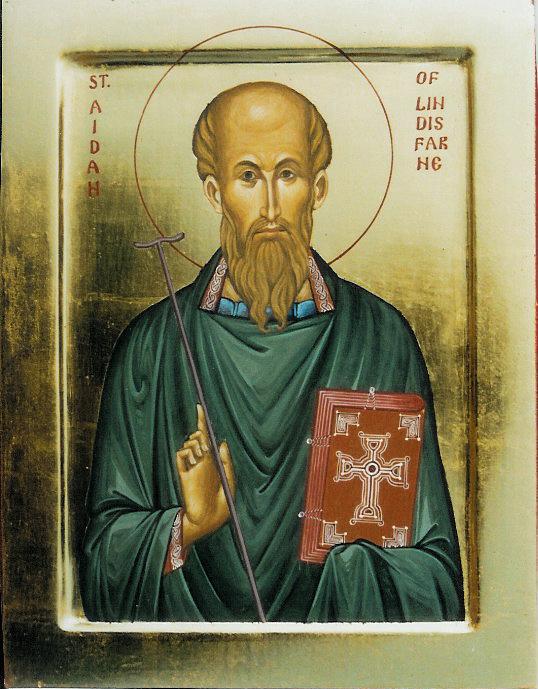The Holy Hierarch Aidan, Bishop of Lindisfarne (†651)
A first approach to the indigenous Orthodox Saints and Martyrs of the Ancient Church who lived and who propagated the Faith in the British Isles and Ireland during the first millennium of Christianity and prior to the Great Schism is being attempted in our website in our desire to inform our readers, who may not be aware of the history, the labours or the martyrdom of this host of Orthodox Saints of the original One, Holy, Catholic and Apostolic Church of our Lord.
"The Church in The British Isles will only begin to grow when she begins to venerate her own Saints" (Saint Arsenios of Paros †1877)
|
SAINT AIDAN was born in Ireland (then called Scotland) in the seventh century. As a monk of the monastery founded by St Columba on the island of Iona, he was known for his strict asceticism. When the holy King Oswald of Northumbria wanted to convert his people to Christianity, he turned to the Celtic monks of Iona, rather than the Roman clergy at Canterbury. St Aidan was consecrated bishop and sent to Northumbria to take charge of the mission. King Oswald gave him the island of Lindisfarne near the royal residence of Bamburgh for his episcopal See. St Aidan founded the famous monastery on Lindisfarne in 635. As bishop, St Aidan was renowned for his humility and piety, a model for other bishops and priests to follow. He was not attached to the things of this world, nor did he seek earthly treasures. Whenever he received gifts from the king or from rich men, he distributed them to the poor. On Wednesdays and Fridays he would fast from all food until the ninth hour, except during the paschal season. From Lindisfarne, St Aidan travelled all over Northumbria, visiting his flock and establishing missions. Oswald, who knew Gaelic from the time he and his family were exiled to Iona, acted as an interpreter for Bishop Aidan, who did not speak English. Thus, the king played an active role in the conversion of his people. One year, after attending the services of Pascha, King Oswald sat down to a meal with Bishop Aidan. Just as the bishop was about to bless the food, a servant came in and informed the king that a great number of needy folk were outside begging for alms. The king ordered that his own food be served to the poor on silver platters, and that the silver serving dishes be broken up and distributed to them. St Oswald was killed in battle in 642 in his thirty-ninth year. St Aidan was deeply grieved by the king's death, but his successor the holy right-believing King Oswin was also very dear to him. St Aidan foretold the death of King Oswin, saying that his people did not deserve such a good ruler. The prophecy was soon fulfilled, for St Oswin was murdered on August 20, 651. St Aidan departed to the Lord on August 31, less than two weeks later. He died at Bamburgh, by the west wall of the church. The beam on which he was leaning to support himself still survives, even though the church was twice destroyed by fire. The beam may still be seen in the ceiling of the present church, above the baptismal font. At first, the holy bishop Aidan was buried at Lindisfarne on the right side of the altar in the church of St Peter. Later, the saint’s relics were translated to Iona, the monastery where he had originally embraced the monastic life. His feast is kept on the thirty-first day of August.
|
